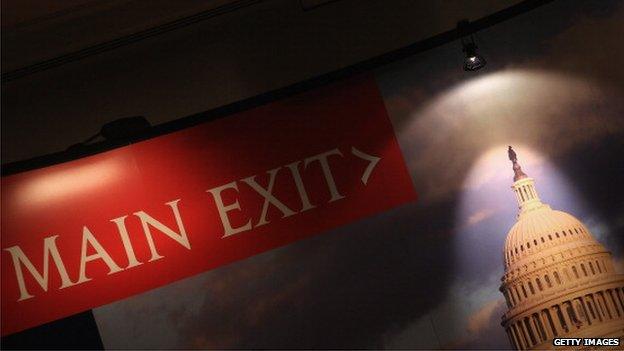US government shutdown isn’t the worst of it
- Published
- comments

The United States government may be forced to shut down at midnight for the first time in 17 years. Sounds ominous? That's not the worst of it.
The bigger problem is, if the Democrats and Republicans continue to disagree, then the US would breach its "debt ceiling" - that means there's a chance that the world's biggest economy could default on its debt.
Firstly, coincidentally, the first government shutdown happened on this day in 1976. Since then, there have been 17 occasions when there was no agreement on the funding of government spending. The last time was 17 years ago during the Clinton administration, which also saw the House and Senate divided over spending priorities.
If the Democrat-controlled Senate sends back the Republican-controlled House version of the spending bill that delays the funding for Obamacare as expected, then 800,000 federal employees won't come in tomorrow and, probably, also the next few days. The shutdowns in 1995 and 1996 lasted five and 21 days, respectively.
There would be a fairly big impact on the economy. Economists estimate that a two-week shutdown could cut GDP growth by 0.3 percentage points and one that lasted three-to-four weeks could cut growth by as much as 1.4 percentage points. That's a pretty hefty hit as the US was projected to grow and an annualised rate of about 2.5% in the fourth quarter.
And then it could get worse - the US could default on its debt.
Technically, the $16.699 trillion debt ceiling was hit on 19 May. The US Treasury has been using extraordinary measures to keep going. If Congress doesn't raise the so-called "debt ceiling", then the Treasury estimates that it can only stretch out the money until 17 October. At which point, it could run out of money to pay the interest on US government debt, and the US defaults in a technical sense if it misses an interest payment.
That is what the debt ceiling is. It is the amount of debt the US can borrow. The problem is the ceiling could now prevent the US from borrowing to pay the interest on the money that it has already borrowed.
Until recently, it wasn't a big issue. Since 1960, the debt ceiling has been raised 78 times. The real debate was always over the spending bills rather than using the debt ceiling as a bargaining chip of sorts.
However, it has become a bargaining point with a divided Congress. This is the third time that there's been a showdown during the Obama administration.
And it has been damaging. In 2011, the US lost its top AAA credit rating for the first time. The rating company S&P made the historic downgrade partly on the basis of the fiscal impasse.
Two years later, the impasse has again reared its head. The timing couldn't be worse as the US recovery is just gaining steam. And the fragile world economy doesn't need the possibility of default by the world's economic engine dangling over it.